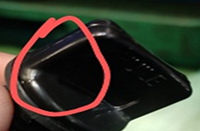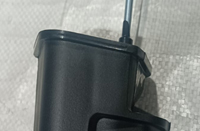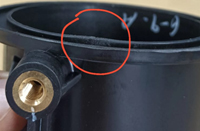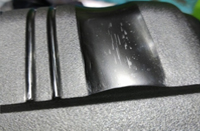Injection molding presents a considerable risk of costly errors. From minor surface imperfections to more severe issues impacting safety and functionality, the spectrum of quality problems is wide-ranging.
Let's delve into the primary quality defects associated with injection molding, their causative factors, and preventive measures.
MOLDING DEFECTS ATTRIBUTED TO PROCESS IRREGULARITIES
While some molding defects pose significant challenges in rectification, others can be forestalled by refining the molding process. Adjustments in flow rate, temperature, or pressure within the mold can often circumvent these defects without necessitating mold tooling redesign or equipment replacement. Hence, with relatively simple adjustments, these defects can typically be sidestepped.
Outlined below are common defects stemming from manufacturing process errors:
1. Flash
 Flow lines, those wavy patterns often discernible on narrower sections of molded components, can be a nuisance in manufacturing, particularly for products where aesthetics matter. Although they typically don't compromise the integrity of the component, they can detract from its visual appeal, making them undesirable in certain consumer goods like high-end sunglasses.
Flow lines, those wavy patterns often discernible on narrower sections of molded components, can be a nuisance in manufacturing, particularly for products where aesthetics matter. Although they typically don't compromise the integrity of the component, they can detract from its visual appeal, making them undesirable in certain consumer goods like high-end sunglasses.
Causes of Flow Lines
The primary cause of flow lines is the differential cooling speed of the material as it flows in various directions within the mold. Disparities in wall thickness exacerbate this phenomenon, leading to uneven cooling rates and the formation of flow lines. For instance, during the injection process, if the plastic cools too slowly due to inadequate injection speed, it solidifies partially and becomes tacky, resulting in the characteristic wave pattern.
Remedies for Flow LinesAddressing flow lines requires a multifaceted approach aimed at optimizing the injection process and mold design. Here are some common remedies:
- i. Increase Injection Speed, Pressure, and Material Temperature
Increasing the injection speed, pressure, and material temperature guarantees rapid filling of the mold before premature cooling sets in. This helps mitigate the formation of flow lines by promoting more uniform material distribution. This helps mitigate the formation of flow lines by promoting more uniform material distribution.
- ii. Optimize Mold Design
Rounding the corners of the mold where wall thickness increases helps maintain a consistent flow rate, minimizing the likelihood of flow lines. Additionally, optimizing the placement of mold gates and increasing the distance between them and the mold coolant can prevent premature cooling, reducing the incidence of flow lines.
- iii. Adjust Nozzle Diameter
Increasing the diameter of the nozzle enhances flow speed, preventing premature cooling and the subsequent formation of flow lines. This adjustment promotes smoother material flow and more homogeneous cooling throughout the mold, reducing the risk of imperfections.
2. Short shot

A "short shot" arises when molten material fails to completely occupy the voids within a mold. Consequently, the resultant molded component remains unfinished post-cooling. Instances of short shots may manifest as incompletely formed sections in plastic display shelves or as absent prongs on a plastic fork, among other examples. Generally, short shots are deemed significant defects capable of impeding both the functionality and aesthetics of the molded part.
Causes and Solutions for Short Shots in Molded Products
The primary cause of short shots typically stems from flow restriction, often due to narrow or obstructed gates. At times, the material's viscosity may be excessive, or the mold's temperature too low, preventing complete filling before cooling occurs. Additionally, trapped air pockets or insufficient injection pressure can also impede proper flow. To mitigate short shot occurrences, consider the following measures:
- i. Redesign the mold to incorporate wider channels or gates, facilitating smoother material flow.
- ii. Enhance injection speed or pressure, or opt for a thinner base material to enhance flow dynamics.
- iii. Elevate mold temperature to mitigate rapid cooling of the material.
- iv. Introduce additional air vents or expand existing ones within the mold to facilitate the release of trapped air.
3. Sink Marks

Sink marks refer to small recesses or depressions that appear on an otherwise flat and uniform surface of a molded part. These imperfections occur when the inner section of a molded component contracts during cooling, causing material to be drawn inward from the outer layers.
Understanding the Causes and Prevention of Sink Marks:
Sink marks share similarities with vacuum voids but differ in their underlying cause and effect. In the case of sink marks on a plastic injection molded part, rather than material cooling too rapidly near the part's exterior, it cools too slowly. Consequently, the material contracts unevenly, pulling the outer layers inward prematurely before sufficient cooling has occurred, resulting in depressions.
To effectively prevent sink marks, several measures can be implemented:- i. Increase holding pressure and extend the holding time to facilitate adequate cooling of the material near the part's surface.
- ii. Extend the cooling time to minimize shrinkage during the cooling process.
- iii. Optimize the mold design by incorporating thinner walls for the components, allowing for faster cooling near the surface.
4. Burn marks

Burn marks typically manifest as dark or rust-colored discolorations on the edges or surfaces of molded plastic components. These marks usually do not compromise the integrity of the part unless the plastic has been significantly degraded by the burning process.
Understanding the Causes and Prevention of Burn Marks:
Trapped air or resin overheating within the mold cavity during the injection process are frequently the main causes of burn marks in injection-molded parts. High injection speeds or excessive heating of the material can exacerbate this issue, leading to overheating and subsequent burns. To mitigate the occurrence of burn marks, consider implementing the following preventive measures:
- i. Lowering the melt and mold temperatures to prevent overheating.
- ii. Reducing the injection speed to minimize the risk of air entrapment within the mold.
- iii. Enlarging gas vents and gates to facilitate the escape of trapped air from the mold.
- iv. Shortening the mold cycle time to prevent prolonged exposure of trapped air and resin to high temperatures, thereby averting overheating issues.
5. Flow marks

In injection molding, flow marks, also known as flow lines or weld lines, occur when the molten plastic material cools and solidifies at different rates as it flows through the mold cavity. This can result in visible lines or marks on the surface of the molded part, which can affect its aesthetics and sometimes its mechanical properties. Flow marks are typically more noticeable in transparent or translucent parts.
Causes of flow marks in injection molding:
i. Injection Speed: High injection speeds can lead to turbulence in the molten plastic, causing flow marks as the material cools unevenly.
ii. Melt Temperature: If the melt temperature is too low, the material may solidify too quickly, resulting in flow marks.
iii. Mold Temperature: Improper mold temperature control can cause variations in cooling rates, leading to flow marks.
iv. Material Selection: Certain materials are more prone to flow marks than others, especially those with high viscosity or poor flow properties.
v. Gate Design: Improper gate design or location can cause flow marks by directing the flow of molten plastic in a way that creates uneven cooling.
Remedies for flow marks in injection molding:
i. Adjust Injection Speed: Lowering the injection speed can reduce turbulence and improve the flow of the molten plastic, reducing the likelihood of flow marks.
ii. Optimize Melt Temperature: Ensure that the melt temperature is within the recommended range for the material being used. Increasing the melt temperature can help improve flow and reduce flow marks.
iii. Control Mold Temperature: Properly control the mold temperature to ensure uniform cooling throughout the part. This may involve adjusting coolant flow rates or using mold temperature controllers.
iv. Material Selection: Choose a material with better flow properties or additives specifically designed to minimize flow marks.
v. Gate Design: Optimize gate design and location to promote smoother flow of molten plastic into the mold cavity, reducing the likelihood of flow marks.
vi. Venting: Ensure proper venting in the mold to allow air and gases to escape, preventing pressure buildup that can cause flow marks.
vii. Injection Pressure:Adjusting injection pressure can help in controlling the flow of the molten plastic and reducing flow marks.
viii. Mold Surface Finish:A polished mold surface finish can help minimize flow marks by promoting smoother flow of the molten plastic.
Conclusion
Manufacturing through injection molding often demands a substantial initial investment in tooling. This underscores the crucial importance of getting your mold design right from the outset, rather than facing the costly prospect of starting over due to significant defects. While defects stemming from the molding process or materials are generally easier and less expensive to rectify, any defects in molded products can severely impact your profitability.
Enforcing strong quality control protocols, like examining raw materials and performing in-process inspections, can efficiently reduce the occurrence of injection molding defects. This approach not only enhances product quality but also reduces wastage rates and enhances customer satisfaction.
At General Plastic Industries LLP, Now equipped with knowledge of common injection molding defects, you can proactively take measures to prevent them in the future, ensuring that your products consistently meet the high quality standards expected by your customers.

